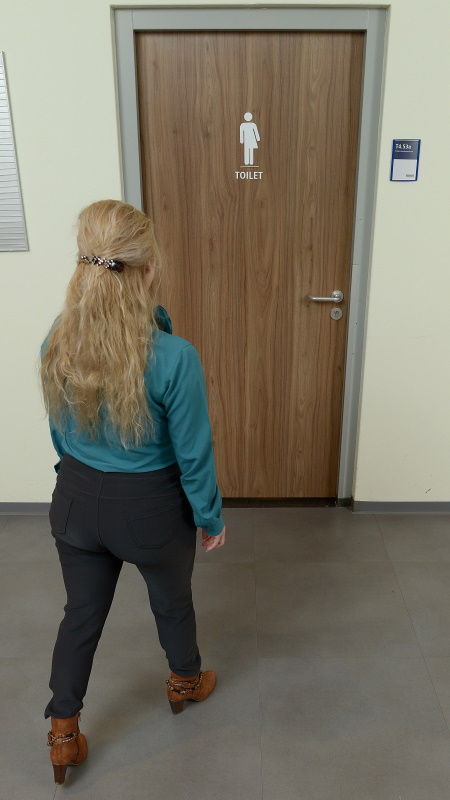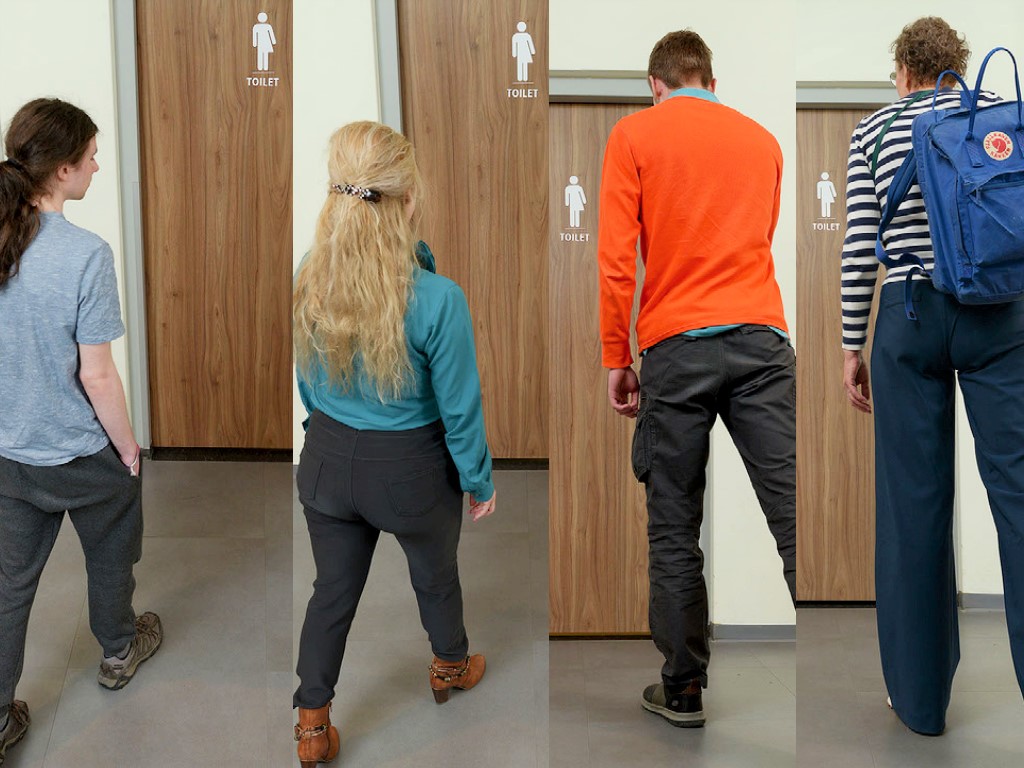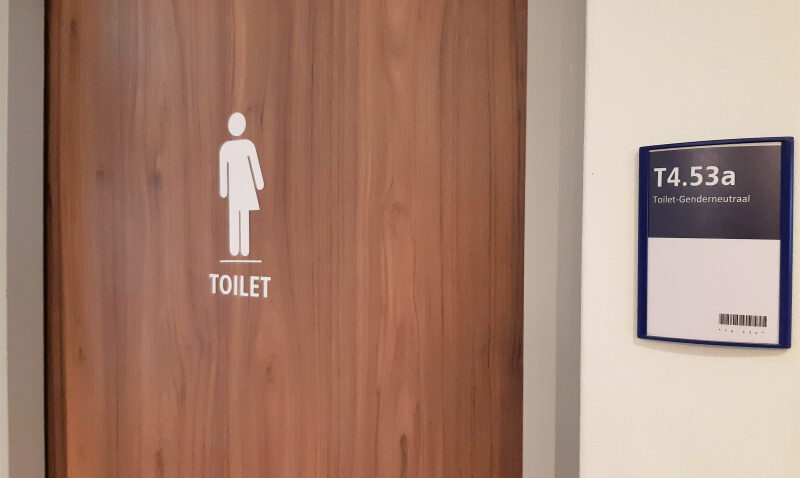Gender-neutral toilets may be installed in all buildings on campus on the ground floor, while the toilets on the other floors will remain separate.
How exactly the gender neutral toilets at Windesheim will look like is still being studied. Inge Grimm of the Executive Board has already informed the Central Participation Council that this concerns a large number and that it is being examined whether 40 percent of the toilets may eventually become gender neutral.
“We are now thinking about large toilet groups with only ‘WC’ or ‘Toilet’ on the door and where no distinction is made. If they are on the ground floor in each building, then it’s also clear for those who are consciously looking for a gender neutral toilet,” says Raimond Hutten of the Housing department.
The rows of urinals will be removed there, some will be brought back behind a closed door.
Hutten is preparing a programme of wishes, together with Miranda in ’t Veld of the Human Resources department and Advisor Diversity & Inclusion Asseliena van Dijk. They are making an overview of the wishes amongst users and ask with which image everyone can agree.
After the summer holidays, Hutten wants to present a practical elaboration to the Executive Board. “We may be able to do a first renovation of toilet groups next autumn. The implementation will in any case take place in phases, so in combination with other renovations.”

‘Our view on gender is going to change a lot’
Windesheim wants to install a large number of gender neutral toilets on campus. The plan is part of a wider societal change in the field of gender, identity and inclusiveness.
Anyone who thinks that the design of a toilet is unimportant is completely wrong. Changes to toilets are food for extensive discussion. And this time it’s not about a small change on campus, but about a plan for a total redesign of toilet groups. And the experience when you walk in there.
In addition to the regular toilet groups, there will probably soon be large toilet groups where there are no longer separate men or women symbols at the entrance. Everyone will be welcome to walk in.
No distinction
Why are these toilets coming? Because of the desire to be gender neutral and to feel safe as a transgender person. Because of the university’s desire to be inclusive and to support transgender people.
In addition, there is a rapidly growing group, especially amongst young people, who wants to live less gender segregated and more equal. They also think a gender neutral toilet is a good idea. The group that sympathizes with this or wants to be inclusive is even larger.
Gender neutral means in the literal sense that no choice or distinction is made as to whether you are male or female. And gender neutral toilets are toilets where anyone, so men, women or non-binary and transgender people, can enter unseparated. Inside a row of doors with toilet cubicles can be found.

Trend sensitive
The gender neutral toilet sounds rather abstract, but that’s because the discussion is fairly new, sensitive and still somewhat taboo. Some students or staff have never thought about it. Others have heard of it, but find a conversation about it uncomfortable.
Those who have a traditional view of the sexes often find an unseparated toilet a ridiculous idea. Those who are sensitive to developments had seen it coming for some time: the embrace of gender neutrality seems to be a logical consequence of emancipation and the inclusive society in which everyone can be who and how they please to be.
Trend-sensitive young people even find it hip to wear cross-gender clothing (which is already available in stores like Zara), or to use gender neutral language (not ‘he’ on ‘his’ bike, but ’they’ on ’their bike’ ). They firmly refuse to fill out on online surveys as to whether they are male or female. They want to deal more loosely with male-female roles, (homo)sexuality and identity. And they prefer to go to a gender neutral toilet.
Discomfort
Windesheim is not the only university of applied sciences to embrace the new development. But the conversation about gender neutral toilets is tricky, a bit like talking about homosexuality years ago. The questions alone arouse hilarity and/or discomfort.
“Why do we all of a sudden all have to go to the same toilet, can’t it just remain this way?”
“Do men and women have to go to the same toilet just because a single transgender person asks?”
“Will men in such a toilet soon be peeping at us when we fix our makeup in front of the mirror?”
“Are women in such a toilet going to peep at us when we use the urinals?”
But also:
“It would be great if we no longer had those separate small meetings in the toilet during breaks, with only men or women.”
Sometimes the discussion is more sensitive when it comes to feelings of safety: “As a transgender person I feel unsafe in a toilet where I am being stared at.” Or:
“I find it scary to have to stand alone at the sink as a woman with a man.”

‘The conversation about gender neutral toilets is like the debate about homosexuality years ago’
Engineering and ICT study programmes
In the T-building in Zwolle, the Engineering and ICT Division has already gained experience with a gender neutral toilet. There, the group of ladies’ toilets on the fourth floor was changed to a gender neutral toilet in 2020, by placing a male-female symbol (see photo) on the door.
Manager of the Study Programme Information & Communication Technology Ilja Clabbers is a member of the Working Group Inclusiveness, that took the initiative for this first toilet. Soon there were calls for more gender neutral toilets. Clabbers expects that the gender neutral variant will eventually cover the entire campus: “It is part of a development in society. And the Netherlands is not even leading the way.
I saw the full transition to gender neutral toilets years ago in Toronto universities. Our view on gender identity is going to change a lot.”
On the rare occasion, he spoke to a student who called the gender neutral toilet an unwanted ‘political choice’, the rest of the students reacted positively. “Windesheim is now taking an initiative that some may object to, but others are expressing their support. The most important thing is that we continue to discuss this subject with each other,” says Clabbers.
T-talk
Students are exactly at the age where you can struggle with all kinds of questions about sexual identity and about gender identity. For years, they have seen a growing group of students in the Engineering and ICT Division who more or less openly admit that they are transgender or non-binary. It’s not just a few, but dozens.
This resulted in the start of a chat/app group called ‘T-talk’, says dean Marianne Timmerman-Hollander, who co-organized this. “It is very important for these students that they feel supported and that no label is imposed on them. It’s very hard to come out of the closet. And if you also want to start your transition, then you will have a very difficult procedure in addition to your studies.”
Is the Engineering and ICT Division leading the way in this? “I think so. Years earlier, we started paying extra attention to gender, also because of the small number of girls who opt for our study programmes.”
Tomboy-style
Journalism student Lieve Govers is one of the members of T-talk and identifies as non-binary. Lieve is happy with the arrival of gender neutral toilets. “I like that it confirms how I feel inside. And that there is room for me to be who I am.”

Lieve already went to have a look at the gender neutral toilet in the T-building. “But because it is on the spot where the ladies’ toilet used to be, only women come there and they experience it as a toilet for women. So it is a step in the right direction, but it would be nicer if there was a large unseparated toilet group where everyone can come.”
Lieve notices that there is a lot of attention for cross-gender expressions amongst young people and on social media. “When male performers like Conan Gray wear a hot pink dress on stage, they show teens that it’s okay to be yourself. Cross-gender clothing is more noticeable in men. A woman in men’s clothes and a ’tomboy’-style for women have already been accepted for some time.”
‘I like that it confirms how I feel inside. And that there is room for me to be who I am.’
‘Boxes’
Most student counselors have spoken to a student who struggled with their gender identity.
Such as Yvette van Heijningen of Information & Communication Technology. “It is very important that these students feel safe here on campus. And that they dare to say that they are different from others. Especially students who are going into transition experience a lot and they undergo hormone treatments or operations.”
Van Heijningen believes the installation of gender neutral toilets in all buildings is a step in the right direction. “I hope that those toilets will eventually be everywhere and that we will stop putting people in boxes. Everyone will just be accepted and a toilet just becomes a toilet.”
Transgender: who is who?
There are many themes around gender identity, the word transgender is an umbrella term. They are generally about people who do not identify with the gender they were raised in. Some want to partially transition or switch completely to the opposite sex, others emphatically want to be neither a man nor a woman.
A transgender man is someone who identifies as a man, but was registered as a woman at birth.
With a transgender woman it is the other way around.
A non-binary person is someone who does not want to identify as either a man or a woman.
A transvestite is a person who wants to dress as a person of the ‘opposite’ sex.
A drag queen is someone who dresses up as a striking woman for a show.
The Transgender Network Netherlands estimates that 2 percent of the population is transgender.

Text: Ernest Mettes
Photos: Ernest Mettes en Jasper van Overbeek
